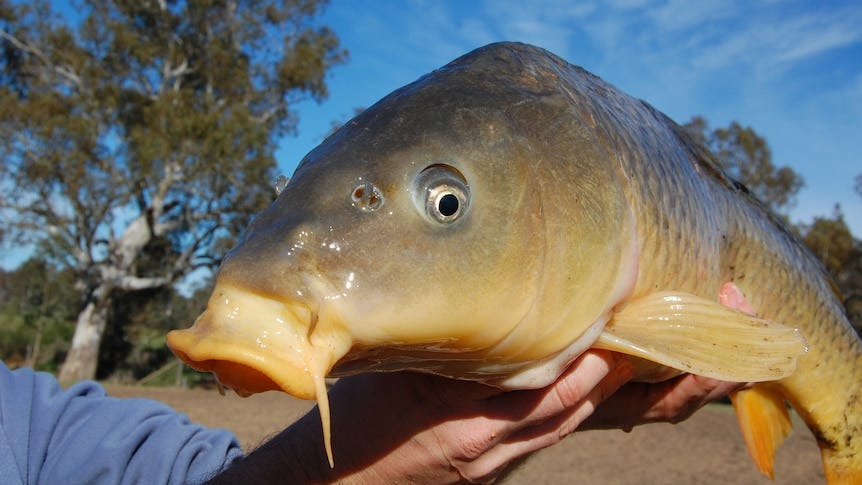
The scene is unforgettable and unforgivable: an elected official, the deputy prime minister of Australia, cutting loose about a fish species introduced into the country by his ancestors, and demanding their annihilation. Cyprinid herpesvirus 3During the near-lunatic display by Barnaby Joyce, even his own colleagues betrayed embarrassment and alarm at the full-throated shrieks of “carp, carp”. With crazed eyes and crimson face, Joyce went on to assure fellow parliamentarians that viral weapons will be deployed against the common carp, otherwise known as Cyprinus carpio. The cannonade of ecological warfare had been announced, though preparations for the war had long been in progress.
In 2017, the Sydney Morning Herald ran a piece befitting the great terror pieces that fret and agitate at the unknown and unseen. “Today no one really knows how many are in the rivers of our eastern states and particularly the Murray-Darling, but if you were to say 10 million, few aquatic scientists would contradict you.”
The carp is inherently consumable, traditional in a number of cuisines, and central to a number of religious rites. But in Australia, the murderous kill comes before sound and sensible management, vengeful destruction before the understanding. As with every species introduced into the vulnerable space of Australian ecology, thuggish retribution for one’s failings is a default position, the cover for human error and incompetence. Often, that retribution is of a colossal, industrial scale, marked by poisoning or viral delivery, connived in by the scientific and political establishment.
The language used to demonise the relevant species never strays far from hyperbole. Federal MP Gavin Pearce stated a few examples in a 2020 speech gloating about Tasmania being “on the verge of eradicating” the common carp. “They are described as water wreckers, resource hogs or trash fish.” In 1994, we find a reference by the Victorian National Parks Association that the fish were biblical dangers akin to “underwater rabbits”. Given that rabbits in Australia have themselves been the subject of experimental torture, liquidation and extirpation for just being rabbits, this was a revealing point.
The wording from the current National Carp Control Plan is less colloquial but no less contemptuous of the fish. “Carp have major negative impacts on water quality and the amenity value of our freshwater environments. Carp also have a devastating impact on biodiversity and have decimated native fish populations in many areas since they first became established as a major pest in the wild in the 1960s.” And whose fault, pray, is that?
The NCCP, comprising 11 national and international institutions, 40 research scientists and work spanning six years is “the largest feasibility assessment of a biological control agent in Australia.” The premise is unmistakable: the use of biological warfare against a loathed animal. While nation states and their human representatives officially shun chemical and biological agents as scourges of humanity, scientists and officials in Australia relish the prospective deployment of Cyprinid herpesvirus 3 (carp virus).
The decision as to whether such an agent will be used, and to what extent, will fall to the various governments in Australia. Committees such as the Environment and Invasives Committee, the National Biosecurity Committee and the Agriculture Senior Officials’ Committee, are all involved in giving advice. “The Australian and state and territory agriculture ministers will be the ultimate decision makers on whether to proceed further with the biological release program following a formal review of the NCCP.”
Such levels of lunacy have been called out, though few critics can be found in Australia. In 2017, University of East Anglia researchers Jackie Lighten and Cock van Oosterhout warned that the herpes virus proposal was of an “irreversible and high-risk” nature, and could have “serious ecological, environmental, and economic ramifications.” While biocontrol measures had been successfully used to target certain terrestrial vertebrates, “the biocontrol of large, highly fecund aquatic animals such as carp adds novel risks.” It was also pointed out that the NCCP had omitted salient areas of work in reaching its findings.
In subsequent work on the subject, researchers have argued that the release of the Koi Herpesvirus would be an exercise in futility in curbing the numbers of the common carp. In time, the creature would develop resistance, seeing a comprehensive recovery of numbers. “KHV will rarely result in prolonged reductions or population extinctions,” write Kate Mintram, van Oosterhout and Lighten in the Journal of Applied Ecology. “Crucially, realistic scenarios result in a rapidly rebounding population of resistant individuals.” The authors go on to state that, “A high probability of population extinction is only met when carp fecundity is reduced to 1% of biological observations.”
As Lighten opined in 2020, “Releasing KHV carries significant risks to human and ecosystem health, which likely outweigh the benefits and we have previously urged further detailed research to avoid an unnecessary ecological catastrophe.” Even in the face of industrial slaughter and biological warfare, this remarkable fish continues to outwit and prevail.
In place of adopting this devastating, daft solution, there are other options: Why not eat and use a species otherwise considered a pest? A chef interviewed on the 7.30 Report was sensibly focused on the gastronomic properties of the common carp, noting that celebrities such as Serbia’s Novak Djokovic eat it with relish. But that selling point is unlikely to fly in the face of the megadeath industry that propels Australia’s often calamitous environmental policies.



